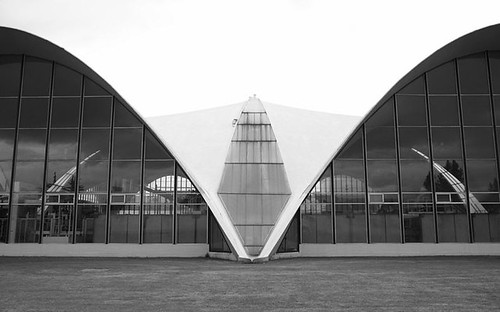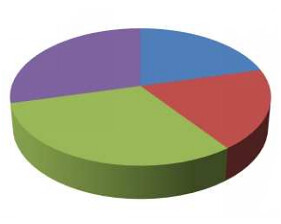What
is the environmental impact of natural and man-made disasters? How can
holistic life cycle thinking impact the way we design for disasters?
Author: Matthew Comber, Lionel Lemay ; Contributors: Frances Yang, Tonatiuh Rodriguez-Nikl
At
the end of 2011, the National Oceanic and Atmospheric Administration (NOAA)
said the U.S. had experienced 14 separate disasters, each with an economic loss
of $1 billion or more, surpassing the record set in 2008 (NOAA 2011). Losses in
2011 amounted to $55 billion in the U.S. Globally, insurers lost at least $108
billion on disasters in 2011. Reinsurer Swiss Re Ltd. said that 2011 was the
second-worst year in the industry's history. Only 2005, with Hurricane Katrina
and other major storms, were more costly (Swiss Re 2011). In 2012, there have
been 11 natural disasters costing $1 billion or more in damage, making 2012 the
second highest year with billion-dollar disasters. Tornadoes in 2012, the
widespread and intense drought that covered at least 60 percent of the
contiguous U.S. and Hurricane Sandy are expected to be the most costly
weather-related disasters in U.S. history.
Figure
9-1 Source: Billion-Dollar U.S. Weather/Climate Disasters 1980-2012 http://www.ncdc.noaa.gov/billions/events.pdf
Most
of the increased disaster losses cannot be attributed to an increased
occurrence of hazards but changes in population migration and wealth. In the
last several decades, population in the United States has increased and
migrated toward the coasts, concentrating along the earthquake-prone Pacific
coast and the hurricane-prone Atlantic and Gulf coasts. Over 60% of the U.S.
population lives within 50 miles of one of its coasts (including the Great
Lakes) (CRSR 1997). At the same time, wealth and the value of their possessions
have increased substantially. The high concentration of people in coastal
regions has produced many economic benefits, but the combined effects of
booming population growth and economic and technological development are
threatening the ecosystems that provide these economic benefits. Moreover, many
elements of these aged infrastructures are highly vulnerable to breakdowns that
can be triggered by relatively minor events (Masters 2011).
Figure
9-2 Sources: GDP Data: MeasuringWorth.com; Storm Damage
Data: Wunderground.com
As a
society, we have placed a great deal of emphasis on recycling rates and
reducing operational energy use in green building codes and rating
systems. However, standard building code
requirements for seismic or wind loads that accept significant damage in a
major event are not addressed. For
example, the latest version of LEED introduced special emphasis on LCA
criteria, but does not recognize disaster resilience as one of its standard
criteria.
There
is a jurisdictional elective in the International Green Construction Code
(IGCC) for performing LCA as a way to demonstrate that a proposed building
has a lower environmental impact than a reference design, but there is no
guidance on incorporating resilience into the analysis. ASHRAE 189.1, Standard
for Design of High Performance, Green Buildings does have an option for
evaluating the embodied emissions of all building materials in a building.
Clause 9.5.1.2 Step 1-1.e does require that maintenance, repair, and
replacement during the design life with or without operational energy consumption
must be taken into account, but it is clear that this is referring to regular
maintenance, repair and replacement and not damage caused by natural hazards.
For
a building to be truly sustainable it should be resilient. It should consider
potential for future use and re-use and have a long service life with low
maintenance costs. (Kestner, Goupil & Lorenz, 2010) In addition, a
sustainable building should be designed to sustain minimal damage due to
natural disasters such as hurricanes, tornadoes, earthquakes, flooding and fire
(Kneer & Maclise 2008). Otherwise, the environmental, economic and societal
burden of our built environment could be overwhelming. A building that requires
frequent repair and maintenance or complete replacement after disasters would
result in unnecessary cost, from both private and public sources, and
environmental burdens including the energy, waste and emissions due to
disposal, repair and replacement.
Resilience and LCA
A
few methodologies have been proposed (Court et al. 2012) and implemented
(Comber et al. 2012 & 2013b, Comber & Poland 2013, Sarkisian et al.
2012) to assess the environmental impacts of seismic damage. At their core,
these methodologies share a common approach: a pairing of a seismic loss
assessment methodology with building component LCA data. The concept of using a
seismic damage assessment to understand environmental impacts is very new-
there is no standard method or procedure, however the methods proposed by these
authors can be very useful depending upon the desired results and amount of
detailed information damage an life cycle inventory data available.
Damage
Assessment
Consideration
of isolated disastrous events can be a useful approach for clients who are
looking at potentially large capital losses associated with direct damage or
downtime during the repair process. Care
should be taken, however, to communicate to the client that these events have a
somewhat small probability of occurrence during any building’s lifespan. A more holistic understanding of a building’s
probable lifetime environmental impacts may be gained by conducting a
probabilistic seismic hazard assessment and examining the potential impacts
across a range of risk levels. Comber et al. (2013a) propose a method for
conducting such an assessment and note the importance of including a
consideration of small- to moderate-sized seismic events in such an assessment.
The
method proposed by Court et al. has yet to be explicitly defined; rather the authors
are currently making recommendations to FEMA for various approaches that may be
feasible. Regardless of the final
version of their approach, it stands to provide a useful method to gaining a
detailed understanding of the building’s impacts and their distributions
throughout the structure. Sarkisian et
al. propose a method and associated software tool that allows a general
understanding of total impacts best used when comparing one structural seismic
system to another. The methodology
proposed by Comber et al. is a more detailed approach that is designed to
target key “environmentally sensitive” components so that the structural and/or
nonstructural seismic design strategy can be adjusted at the project outset to
best protect those components from damage.
A common theme can be found throughout these authors’ approaches: the
role of the structure (and thus the structural engineer) must often be
heightened to one of protecting nonstructural components in order to
effectively minimize impacts of seismic damage.
Environmental
Impact Data
Sarkisian
et al. propose a process-based LCA that is defined in terms of material
quantities, whereas Comber et al. use an Economic Input-Output LCA that is
based on a building cost estimate (more detail on their EIO procedure is
presented by Comber et al. 2013a).
Sustainable Building Standards
For
green building standards to truly address sustainable construction, the concept
of disaster resilience must be addressed. State-of-the-art modern buildings are
no doubt currently in construction that are designed to meet LEED or other
green building requirements that could be easily destroyed as a result of a
hurricane, earthquake or other force of nature.
There is a high risk that the monetary & environmental investment
made to create high-efficiency systems in these buildings will not generate a
return if the building undergoes damage due to a natural hazard event. A consideration of the risks and benefits
associated with resilient design strategies would ensure that the statistical
minimum lifetime environmental impacts are realized in these designs.
References
Comber M.V., Poland C., Sinclair M. (2012). “Environmental impact seismic assessment:
application of performance-based earthquake engineering methodologies to
optimize environmental performance.” Proceedings,
American Society of Civil Engineers/ Structural Engineering Institute
(ASCE-SEI) Structures Congress, Chicago, IL.
Comber, M.V., Erickson, C., & Poland, C. (2013a).
“Quantifying and Minimizing the Environmental Impacts of Seismic Damage to
Buildings: A Procedure and Case Study.” Journal of Structural Engineering, in
review.
Comber, M.V., Poland, C., & Sinclair, K.M. (2013b). “Sustainable
Concrete Structures through Seismic Resilience: A Case Study.” Proceedings, International
Concrete Sustainability Conference, San Francisco, CA.
Comber, M.V. & Poland, C. (2013). “Disaster
Resilience and Sustainable Design: Quantifying the Benefits of a Holistic
Design Approach.” Proceedings, American Society of Civil Engineers- Structural
Engineering Institute (ASCE-SEI) Structures Congress, Pittsburgh, PA.
Congressional Research Service Report (CRSR). (1997). Oceans
& Coastal Resources: A Briefing Book, Congressional Research Service Report
97-588 ENR.
http://www.cnie.org/NLE/CRSreports/BriefingBooks/Oceans.
Accessed November 13, 2012.
Court A., Simonen K., Webster M., Trusty W., Morris P.
(2012). “Linking next-generation
performance-based seismic design criteria to environmental performance (ATC-86
and ATC-58).” Proceedings, American
Society of Civil Engineers/ Structural Engineering Institute (ASCE-SEI)
Structures Congress, Chicago, IL.
Economic Policy Institute (EPI). (2012). State of Working
America,
http://stateofworkingamerica.org/chart/swa-wealth-figure-6a-average-household-net.
Accessed November 13, 2012.
Kestner, D, Goupil, J. & Lorenz, E. ed. (2010). Sustainability Guidelines for the Structural
Engineer. American Society of Civil
Engineers Structural Engineering Institute, Reston Virginia.
Kneer, E., & Maclise, L. (2008). “Consideration of
Building Performance in Sustainable Design: A Structural Engineer’s Role.”
Proceedings, Structural Engineers Association of California (SEAOC) Annual
Convention.
Masters, J. (2011). 2011’s Billion-Dollar Disasters: Is
climate Change to Blame?, Weaterwise, March-April 2012,
http://www.weatherwise.org/Archives/Back%20Issues/2012/March-April%202012/dollar-disasters-full.html.
Accessed November 13, 2012.
National Climate Data Center (NOAA). (2011).
http://www.ncdc.noaa.gov/billions. Accessed November 13, 2012.
Sarkisian M., Hu L., Shook D. (2012). “Mapping a structure’s impact on the
environment.” Proceedings, American
Society of Civil Engineers/ Structural Engineering Institute (ASCE-SEI)
Structures Congress, Chicago, IL.
Swiss Re Estimates 2011 Economic Cat Loss at $350 Bn;
Insured Loss $108 Bn. (2011) http://www.insurancejournal.com/news/international/2011/12/15/227534.htm,
accessed November 13, 2012.
Return to Top 10 Home
Return to Top 10 Home




















